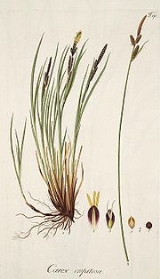
Carex cespitosa
Encyclopedia
Carex cespitosa is a species of perennial
sedge of the genus Carex
which can be found growing in bundles as the Latin
specific epithet suggests. The species is able to hybridise with the common sedge (Carex nigra
) to produce a 20–50 cm (7.9–19.7 ) tall plant, flowering from May to June. The species can be found in all of Scandinavia
, ranging from common to rare, as well as central parts of Europe, excluding Britain.
Perennial plant
A perennial plant or simply perennial is a plant that lives for more than two years. The term is often used to differentiate a plant from shorter lived annuals and biennials. The term is sometimes misused by commercial gardeners or horticulturalists to describe only herbaceous perennials...
sedge of the genus Carex
Carex
Carex is a genus of plants in the family Cyperaceae, commonly known as sedges. Other members of the Cyperaceae family are also called sedges, however those of genus Carex may be called "true" sedges, and it is the most species-rich genus in the family. The study of Carex is known as...
which can be found growing in bundles as the Latin
Latin
Latin is an Italic language originally spoken in Latium and Ancient Rome. It, along with most European languages, is a descendant of the ancient Proto-Indo-European language. Although it is considered a dead language, a number of scholars and members of the Christian clergy speak it fluently, and...
specific epithet suggests. The species is able to hybridise with the common sedge (Carex nigra
Carex nigra
Carex nigra Reichard is a perennial species of plants in the family Cyperaceae native to wetlands of Europe, western Asia, NW Africa and E North America. The eastern limit of its range reaches central Siberia, Turkey and probably Caucasus....
) to produce a 20–50 cm (7.9–19.7 ) tall plant, flowering from May to June. The species can be found in all of Scandinavia
Scandinavia
Scandinavia is a cultural, historical and ethno-linguistic region in northern Europe that includes the three kingdoms of Denmark, Norway and Sweden, characterized by their common ethno-cultural heritage and language. Modern Norway and Sweden proper are situated on the Scandinavian Peninsula,...
, ranging from common to rare, as well as central parts of Europe, excluding Britain.
Cultural references
- John Bauer's famous painting Princess Tuvstarr has taken its name after the Swedish term for this plant.

